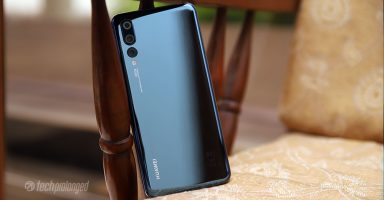Display & Battery
Huawei P20 Pro – Display & Battery
With the minimal chin bezel, the P20 Pro has almost zero bezels on the left, right and top edges edges. Though the phone had to host the earpiece and other common sensors along with the front camera, the display is cut through with a notch. That notch takes less much less space on the screen unlike iPhone X – less than one third of the width with only few millimeters vertically.
The 6.1-inch screen of P20 Pro is taller with Huawei’s FullView AMOLED display. It’s company’s “best screen to date to deliver superior color gamut”. It serves with full HD resolution of 2240×1080 pixels at aspect ratio of 18.7:9 and pixel density of around 408 ppi.
Huawei seems not to be really friendly with QHD screens as they tried going for this higher resolution in last year’s P10 Plus and then Mate 10 as well. But the company didn’t want to bring it on and the P20, P20 Pro both has full HD resolution. Frankly speaking, I am happy with that especially if it helps keeping the battery juice for long run.
As you can see there is no physical navigation buttons on the bottom bezel but only a home button, the on-screen navigation is present. You get additional content area on the screen due to the status bar shifted around the notch on top. If you are one like me and do not like to have that unneeded notch interference, thankfully Huawei has provided an option to virtually hide the notch into darkened status bar. The status information remains right at their places and feels like you the top bezel with display.
If we talk about display performance, Huawei P20 Pro has good brightness control. In fact auto-controlled brightness goes beyond what the manual max brightness would do. Overall it’s good improvement over P10 even when P10 had LCD which should be brighter theoretically. So the AMOLED display of P20 Pro is appreciable for being brighter.
Contrast ratio is also impressive outdoors under sunlight but the screen still has less reflection control. So when that bright sunlight comes with shadows, it becomes troublesome in sometimes.
To deal with your own color preference, Huawei has given a range of color options with presets and manual overrides. You can control vividness and saturation as well as color temperature on top of it. You can also turn-on eye comfort to reduce the bluish tint if you want.
I found the darker overall interface better and more comfortable to the eyes than the white one. The option to set this is not in the display settings, not in themes, but in the battery settings.
Where most of the flagship phones feature around 3300mAh battery capacity, Huawei has long been using larger batteries. P20 Pro is no different and boasts with a 4000mAh battery.
It’s not only the numbers, during our tests Huawei P20 Pro has performed pretty nicely with battery consumption on various occasions. Most importantly, being a camera phone, P20 Pro lived up to the mark in the field with losing battery in affordable way.
Video playback and browsing were moderately good while the GPS navigation takes the battery juice more than than other tasks. Gaming on the other hand varies from one title to the other. Overall the P20 Pro did well as a daily runner with two SIM cards – one connected at LTE network while the other is on 3G.









